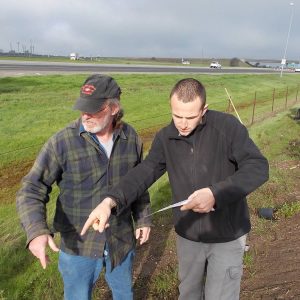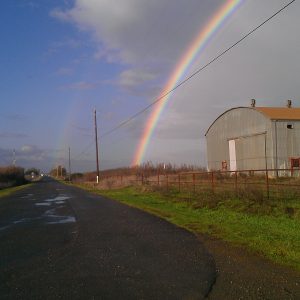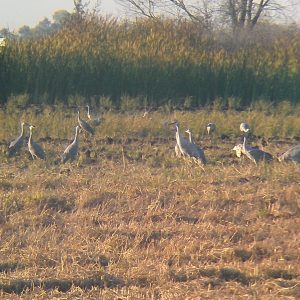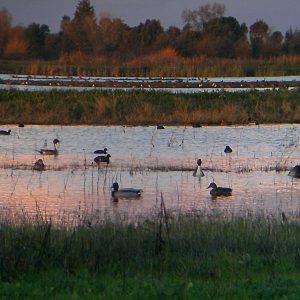Another spring season has started here in the Central Valley of California and with it comes the inevitable, weeds. A significant component of my internship at the Cosumnes River Preserve is identifying, mapping, and treating weed infestations. It is not my favorite task, but I believe it is a necessary evil. This year looks to be an especially busy one. It seems new invasive populations are popping up out of the woodwork.
Last Thursday I was able to plant at my RD-150 restoration site with the help of fellow preserve co-workers. We had a great day for the planting and encountered minimal complications (Can we still consider this a restoration?!) Any other free time I have had in the past several weeks has been dedicated to writing the NEPA document for one of my other projects.
Until next time!!

Author Archives: Galt, California
Drought continues
The drought continues here in California. We did have a few small rain events since my last blog. They brought enough water to create flooding (ironic because we are still in a “drought” and have had less than 20% of average rainfall). Water restrictions in Sacramento have been increased to 40% and are being called “mandatory”, but because less than half of the residences in the city have water meters, this is virtually impossible to enforce. Further complicating the issue is that a significant amount of the water used in the state is by farmers and comes from private farm wells, which from what I understand is highly unregulated. In addition, many cities in southern California sell water like a commodity, so local governments are hesitant to put restrictions on water usage fearing lawsuits from water companies. The entire issue seems quite messy but the bottom line is that there is going to be catastrophic consequences in this state if people don’t start taking the issue of water conservation more seriously.
As part of my position here at the Cosumnes River Preserve I am responsible for overseeing some of the restoration projects currently underway. I have made water conservation and efficiency major considerations in my irrigation system designs for these projects. We actually just had a very successful workday last Thursday (2/13) and were able to get one of my drip irrigation systems fully installed. After months of project reports, proposals, quotes, supply ordering, conceptualizing, schematic drawings, meetings, etc. it is always very exciting to finally see a part of your project installed and functioning properly. This particular site is fully prepped and ready for plant installation. Most of what we will be planting are cuttings of native species which I identified and collected several weeks ago from my reference site less than a mile away. The cuttings are a great way to save money when funding is tight and depending on where you collect can also ensure that you are not introducing new, genetically inapt plants to your site. More details as project progresses…
Birds missing
Hi All,
I’m stationed at the Cosumnes River Preserve just south of Sacramento, CA. If you don’t already know, California is experiencing a sever drought right now. Despite the wonderful upper 60’s lower 70 degree daytime highs, this could potentially be very bad. Although this is supposed to be our rainy season, we have not had any precipitation in over a month, and forecasts are already predicting no rain in the month of February. The Folsom reservoir, which supplies water to the greater Sacramento area, is under 20% full for this coming “dry” season. The water is so low in the reservoir that a city that was flooded in 1955 with the creation of the lake is now once again becoming visible. The city of Sacramento has already asked residents to begin reducing water usage by 20%. This is going to be an especially dangerous fire season in California if this dry weather continues.
The unusually dry weather has also had a major impact on the wildlife migration patterns in our area. The Preserve acts as a major winter refuge for birds using the pacific flyway. This year, the birds just haven’t shown up. The wetlands here would typically be blanketed with a solid covering of birds this time of year. Unfortunately, we have yet to see any substantial numbers in our bi-monthly bird counts. Many birds further north are not making the trip down this year thinking they are still in summer season, while others that have already made the trip to our area are heading back north thinking winter is over. These birds seem to be very confused, and it is disconcerting to think of how this might impact future populations.
My tasks here are never ending (I am perfectly happy with that). Most recently I’ve been working on GIS maps, facility maintenance (gutter repairs, sign installations), invasive plant recon, permitting for some of the restoration projects I am working on and equipment maintenance in anticipation of the outdoor work (summer) season. In addition to my primary responsibilities I typically help with general tasks here like wetland water management, and all activities relating to our integrated pest management program. I should be federally certified as a pesticide applicator by the end of February. That being said, life is good here (at least while the water lasts).
Great trainings, great experiences, great employment preparation. CLM
Stay warm-
Snow? Probably not.
Season’s greetings!
I have been fortunate enough to receive a funding extension here at the Cosumnes River Preserve where I have been stationed for the past several months. I came to California from Iowa as a CLM intern in May 2012 to work for the BLM at the Cosumnes River Preserve. I participated in SOS collections, and had a plethora of other tasks which included everything from plant identification to fixing the kitchen sink (literally) and everything in between. During my first term I was able to network with other CBG interns in my area and organized collecting trips where we were able to travel to do special seed collections. Collecting native seed in the mountains with a group of other well informed biologists is about as good as it gets for me. It was a great opportunity to network with fellow interns and combine resources for maximizing efficiency. A great time was had by all! When funding from the BLM for my position became constrained, I did go to work for The Nature Conservancy for a brief period last summer doing botanical surveys and data collection, but have gratefully re-joined the Chicago Botanical Garden once again.
I came back to work for the BLM in November 2013 as a CBG intern, and have taken on some new responsibilities. I will, hopefully, still be coordinating with other CBG interns at the field office and participating in some SOS seed collections during this coming growing season. I love spending time in the field, and SOS collections provide great opportunities to work outside. However, my primary responsibility here now will be doing some project management. I will be in charge of overseeing several restoration projects taking place here at the Preserve from start to finish. This will be an opportunity to learn the federal processes of permitting, bidding/contracting labor, using field restoration techniques, and evaluating project successes/failures, among other things.
Additionally, with all of the “cold” (California cold- 50’s) weather we have been experiencing, I have taken on several mapping projects. I love working on GIS projects. It is such a valuable tool in our field if you take the time to figure out how to use it. Many of the Preserve’s maps are out of date so I have been compiling data and updating these. I have also been out collecting data to create maps with information that has never before been displayed. The more GIS practice I can gain the better. There is so much we can learn through the use of this program. If you have ever used ArcMap and been frustrated, join the club, but don’t give up on it.
When I have not been busy with one of the restoration or mapping projects, I have been involved with several other fun ongoing activities at the Preserve. Every other Wednesday there is a bird survey to record how many birds are using the Preserve, and which units they are utilizing. This is always a fun and educational activity. There is also talk of a mountain lion study taking place here in the near future which I’m hoping to participate in. It seems like there is always something new here if you are looking to get involved. When I get a weekend with no plans, I like to head into the mountains. Several times last summer I backpacked in the South Warren Wilderness (northeast corner of CA), quite possibly the only place in California where you can still truly find solitude. On one trip I hiked for two days without encountering another human being. It was glorious! Included are some photos from South Warren-
Merry Christmas friends and co-workers!
The End
What an adventure this has been. Next week is the last week of my internship here in Galt, CA at the Cosumnes River Preserve. It has been a great experience. I have made a myriad of professional contacts, greatly expanded my knowledge of California plants, and gained valuable hands-on experience with California land management.
After finishing up a bachelor’s degree in 2009 from the University of Northern Iowa, I set out to find a job in the natural resources field. As anyone who has ever tried this knows, it was tough. Jobs were scarce and the few that did exist had so much competition it seemed impossible to get in. I finally succeeded in securing a job with a small county conservation organization in Iowa where I worked as a natural resources technician for about 2 years. I loved the work I was doing, but I came to the conclusion that I wanted to go back to school to pursue an advanced degree.
After finishing all of the coursework for a PSM degree by the spring of 2012, I needed to find an internship to complete the degree. This was when I found the CLM internship program. I applied for the program and was accepted. After a few interviews, I was hired to intern with the Bureau of Land Management at the Cosumnes River Preserve in Galt, CA. I have been working here since May of 2012. My work has been extremely diverse; I have had the pleasure of doing everything from seed collection for the SOS Program to banding of endangered cranes to taking genetic samples of endangered red-legged frogs and EVERYTHING in between. I have been allowed and encouraged to continue my education through attendance and participation in seminars, workshops, and special events. These events have also been instrumental in networking with others in the field.
I have applied for many full time jobs over the past several months, but have been met with limited success. Despite the frustrations, I am confident that I will find the right position with the skills and experiences I have gained through this internship. In the meantime, I have secured a temporary position with the Nature Conservancy as a vegetation technician for this field season.
The CLM internship has been an awesome experience for me, and also one of the building blocks of my career. Through the CLM program, I have been working my dream job for the last 12 months. The work is physical, but rewarding. There is nothing else I would have rather been doing. If you are considering a CLM position, consider this an A+ recommendation.
Wet season in full force
Very little has changed here since my last post. The wet season is in full force here and my duties have shifted to mainly office work. I have re-entered the realm of GIS. It is definitely a good thing I am doing this work because despite having taken a GIS course less than a year ago, it seems I have already fallen out of the loop. Although the office work is not quite as appealing to me as the wonderful amazing superb field work I get to participate in, this rainy cold weather has also caused a dramatic increase in our wintering bird population numbers. Tens of thousands of geese, ducks, and cranes have arrived here at the Cosumnes River Preserve. The bird watching is in full swing and is reflected in the survey numbers we have recorded in our monthly bird counts.
- Interpreting our hedgerow layout plan to ensure diversity
- Briefing our volunteers on our goals for the day and what to expect at the work site
- A momentary break in the rain revealed this stunning display of color.
- These sandhill cranes are a few of the many using our preserve as a winter resort. Greater sandhill cranes are federally endangered (around 10,000 left in the world) while the lessers are more common. Both subspecies use our preserve but differentiation can be tricky.
- This is just one of our many ponds specifically managed for ducks.
Occasionally, we have still been experiencing “nice” days here and there. These momentary breaks in the rain provide much needed outdoor work time. I was fortunate enough to have a group of volunteers assist me with a hedgerow planting that I have been working on (weather permitting). With the help of the volunteers, we were able to plant a combination of 180 native shrubs along one of our properties which borders an interstate. The planting will serve as bird habitat for passerine species as well as a “trash rack” to intercept pieces of garbage blowing off of the roadway. With Christmas right around the corner, many of our employees are taking time off for vacation. I’ll be looking forward to spending some time with family as well. Merry Christmas!!
Holiday!
… and then one day it started rainin. The rainy season has begun here in the California central valley. The fields have turned back to a familiar green color. The weather has still been very mild. Rainy days mixed with 60-70 degree sunny days. Being the intern here I have been assisting with all of the random odds and ends. There is never a shortage of work for me. My projects have included things like fencing closed sections of the preserve, seeding restoration areas, and guiding tours, among other things. Most recently I had the opportunity to work with school kids on a native shrub planting. The kids were a blast to work with, and hopefully these volunteer opportunities might spark an interest in conservation for one or more of them. Tomorrow morning we have staff meeting, followed by a presentation by a rattlesnake biologist, and in the afternoon I will be planting more native shrubs. I love this job.
Let it ride!!
As I knew they would, the five months of this internship have flown by. I have had great experiences and opportunities ranging from banding endangered Sandhill Cranes, to genetic sampling of California Red-legged frogs, to surveying for endemic plants. The work has definitely held my interest; so much in fact, that I have decided to stay. I have been offered an extension which I gladly accepted. The rainy season is just around the corner here which means one thing on the Cosumnes River Preserve, BIRD SEASON!! The birds have already started arriving by the thousands. I am not an experienced “birder” but it is something I am going to pick up while I’m here. Our wetlands are the winter home to thousands of Sandhill Cranes, ducks, geese, and other birds. I will be assisting with bird surveys one day a week while they are here. I will be sure to include some of my wildlife photos in my next blog entry.
Much of my free time in the past month has been spent seed collecting and identifying plant species for potential collections. Although many parts of California have dried out completely, there are still many flowering species here on the wetland.
We have had some very large scale drug operations on the preserve lately. This has restricted my work and collections as entire sections of the preserve have been shut down to all types of operations. It’s one more danger to add to the already substantial list of potential threats.
Between the weather elements, the unfriendly environments, and additional dangers of our jobs, it has become abundantly clear that seed collection is not always a walk in the park! I’m sure this type of work is not for everyone, but for me, there’s nowhere else I would rather be.
The wildlife viewing has continued to be outstanding here. I regularly see coyotes, owls, pheasants, snakes, river otters, minks, deer, turtles, quail, eagles, hawks, turkeys, rabbits, lizards, and ground squirrels, among other critters. We also have a large population of feral cats inhabiting the preserve and although cute and fluffy, feral kittens are born dangerous!
Most recently we have been doing work to prepare for the fall “flood-up”, when our artificial wetlands are flooded for the large numbers of migrating birds passing by. I am hoping I will have the opportunity to see these magnificant creatures arriving by the thousands.
Heating up
The weather here in Northern California has finally started warming up, but with no humidity I have found it is still quite pleasant. Seed collections are occurring frequently now, with new seeds ripening every week. I have been able to get out to collect with a couple of other CBG intern groups. The company has been good (thanks guys and girls). We had an awesome opportunity to band Greater Sandhill Cranes two weeks ago in Modoc National Wildlife Refuge with the US Fish and Wildlife Service. This was a very cool experience, although slightly less technical than I had assumed. You spot “suspicious” looking cranes in the field as you’re driving by, slam the vehicle into park, and sprint out to them hoping to find a juvenile crane in the grasses. You then grab the crane, and glue a sequence of bands onto its leg. It’s not rocket science, but they can learn a great deal about the cranes from doing this. Breeding site preference, age, mortality rate, and other types of information are all recorded from the simple bands. I am attending a rattlesnake seminar this month on rattlesnake courtship (seems a very dangerous and entertaining subject) and will be tagging along on a survey for Spivey frogs on the 30th. Life is good.


![IMG_20140213_140150713[2]](https://dev-clm-blog.pantheonsite.io/wp-content/uploads/2014/02/IMG_20140213_1401507132-300x168.jpg)
![IMG_20140213_140134969[1]](https://dev-clm-blog.pantheonsite.io/wp-content/uploads/2014/02/IMG_20140213_1401349691-300x168.jpg)
![IMG_20140213_135535023[2]](https://dev-clm-blog.pantheonsite.io/wp-content/uploads/2014/02/IMG_20140213_1355350232-300x168.jpg)










